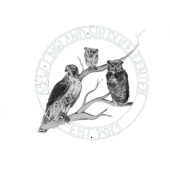
At the New England Wildlife Centers located in Barnstable and South Weymouth, we answer wildlife calls from the public seven days a week. We answer approximately 15,000 wildlife calls a year. These lines are answered by licensed wildlife rehabilitators and they are able to provide answers to most questions. The goal is to keep as many animals in the wild with their families as possible while being available to care for any sick, injured or truly abandoned ones. The information provided to the caller can help them make appropriate choices when trying to help the animal.
We get calls for virtually every species in Massachusetts, and some that are beyond our borders. Recently, we received a call from a beachgoer in Tel Aviv who wanted advice on how to help an injured seagull. We like to think that we have dealt with just about every conceivable situation that wildlife can get into, but wild animals and the people who care about them never cease to surprise us. That being said, the majority of the calls we take are repeats and pertain to common situations that arise with our most abundant species. Here we will address the most common calls that come into our center in the hopes that it will help the next time you encounter one of these situations.
What do I do with:
A turkey with an injured leg. Easily this is one of our top ten questions. Turkeys injure their legs in many ways from car strikes, to turkey-on-turkey violence, to predator attacks. The truth is that unless the injury is caught quickly, treatment options are limited. Birds tend to heal at about twice the speed of humans, which means fractured bones often set in improper positions leaving them with an ill-proportioned limb. By the time they reach our hospital there is usually not much we can do to improve their gait. The good news is that a turkey who is permanently limping can generally adapt well to their environment. If the turkey can fly so it can roost at night and escape predators, and if it can hunt for food then it is usually better to leave it in its home environment. If they can fly they are difficult to catch and our interference stresses them out. As difficult as it is to watch a limping turkey, know that they will best survive in the wild.
A bird on the ground that is hopping and can’t fly. Many species of birds leave the nest to fledge before they can actually fly. (not really a great design plan). A bird that is fully feathered and looks like a miniature adult is generally a fledgling. They have left the nest and they can’t fly so they hop around. The parents are nearby and watching over them. In a few days they will be able to fly. They are not hurt, just in a learning stage. Leave them where they are unless it is a dangerous spot, and then move them to the closest safe spot.
A squirrel is running up my leg and/or followed me home. As crazy as it sounds, this is typical adolescent squirrel behavior. These juveniles have left their nest to be on their own and they are just getting used to the outside world. They look like miniature adults and are very curious. They will follow people, sit on their shoes and run up their leg. Once we even had a squirrel ride a golden retriever for several blocks, much to the dismay of the owner. The dog did not seem to mind. Despite this behavior being endearing and adorable, it is best to show them tough love by discouraging them away from you and back into a natural environment. This will stop as they get older.
A bunny nest that is destroyed. Eastern Cottontails build very shallow nests in inconvenient spots. The nest is only a few inches deep covered by grasses and the mama’s fur. They will nest in your garden, or in the middle of the lawn. The nests are often not seen unless something disturbs it like a cat or dog or a lawnmower. If you come upon a disturbed nest, put all the babies back in it and cover if with the grasses and leaves and fur. Then put string across the top in a tic -tac- toe pattern. The mother returns only twice a day to feed at dawn and dusk, and if she returns the string will be moved. If she doesn’t return after 24 hours, contact a wildlife rehabber. If any bunnies are injured or have been in the mouth of a pet, they should be seen at a wildlife hospital.
A fox or coyote with mange. This is one of the most heartbreaking situations. Mange is a skin disease that is easily spread from animal to animal. The animals lose their hair, get skin infections, and become debilitated. It is a treatable disease, but the animal needs to be brought to a wildlife hospital. In Massachusetts, it is illegal for anyone to trap an animal for any reason including medical treatment. It is also illegal to medicate animals in the wild. This means any animal with mange must be able to be caught with a net or catch pole. These animals must be caught by professionals like your local animal control officer. Foxes and coyotes are a rabies vector species and need to be handled so no one gets hurt including the animal. These precautions often make the capture process a multi-day effort, but the success of treatment is high and well worth the extra work. If you see an animal with mange, please call your local animal control officer. When caught legally it can be brought to a hospital for treatment and rehabilitation.
A bird flew into my window. Window strikes are very common and most of the time with a bit of a rest period the bird should be able to fly away. We suggest that you leave the bird where it fell if it is a safe place. Wait for an hour to see if it is showing signs of moving better, sitting upright and making attempts at flying. About 80% of window strikes fly off on their own. If it isn’t recovering during that time, pick it up and put it in a box on something soft and call a wildlife hospital. To prevent strikes you can put up decals on the windows or hang flags or streamers.
A turtle hit by a car. Turtles crossing the road are a major problem especially during mating season. They will not be deterred on their mission. If you see a turtle in the road, and it is safe for you to do so, gently move the turtle to the side of the road in the direction they are heading. If it is a snapping turtle take extra caution to not get bit by using a stick or piece of cardboard to help propel it. Do not put your hand near their mouth. If you have to pick up an injured turtle, support it under its bottom shell (plastron) and do not pick it up by the sides of the top shell (carapace). Transport it to a wildlife hospital.
A turtle laying eggs in my yard. First, feel excited that you will get to witness the miracle of a turtle hatch. It is amazing. Once a turtle has chosen the spot to lay her eggs, she will dig a hole, lay her eggs and then leave. She has nothing more to do with them. Most times you don’t need to do anything either. If you think the nest is in danger from predators, do not move the nest. Put wire mesh around it to mark and protect it. Turtle eggs take about 60 days to hatch. Around that time remove the mesh so they can leave unimpeded. They will hatch and take off on their own. Take pictures. Many species of turtles are endangered or of special concern in Massachusetts, so each hatchling is important. These turtles are wildlife and should not be raised as pets.
A gull with an injured wing. Like the turkeys, gulls and other waterfowl with injuries are difficult to catch if they can fly. Gulls commonly injure their wings by fighting, car strikes, and fishing equipment entanglements. If the gull cannot fly (and you are fast enough) then they can be captured to brought for treatment. The best way to safely capture a gull is to throw a towel or sheet all the way over the bird, making sure to cover the head, and scoop them from underneath. You can then place them in a dark quiet box or bin for transport. Please avoid using all-metal dog kennels as they can do long-term damage to the feathers and wings. It is important to note that large birds like gulls, cormorants, swans, geese, and gannets can do serious harm to their rescuer if they are handled improperly. It is often best to call animal control to help with the capture. To help prevent some injuries pick up all fishing gear and dispose of properly.
A bat in my house. Bats do not want to harm us when they come into our homes. They are looking for a place that is safe and warm to roost. They can get in through tiny cracks and vents and under shingles. If you see a bat in your house, it is important that it is caught properly. Bats are a rabies vector species and cannot be handled without risk. If the bat is found in the bedrooms, kitchen, living room, or other heavily trafficked living-spaces you should call your local animal control or the department of health right away to ensure you are not at risk. Calling a professional is always best to capture them. At times they will leave the house on their own at night to hunt and then return. If you know where they are coming in, you can close the entry when they are out at night. If you have one bat, chances are there are more, so you should have your home checked. To prevent bats form entering, seal up any areas in your home that can be a point of entry. Putting up a bat box gives them a place to go instead of your house and they will provide you with free mosquito control.
Here are some resources to help you with your wildlife questions:
Birdsey Cape Wildlife Center 508 362 0111. www.capewildlifecenter.com
Mass.Gov/wildlife-rehabilitation
Your local animal control officer or department of natural resources officer listed on town webpage
Massachusetts Fish and Wildlife 617 626 1575
Massachusetts Environmental Police 800 632 8075
To learn more about the Cape Wildlife Center or help in their mission, visit www.capewildlifecenter.com or call 508 362-0111.
Caryn Ritchie is on staff at the Cape Wildlife Center and holds both a Massachusetts wildlife rehabilitator’s license and a federal permit to rehabilitate migratory birds.

Recent Comments